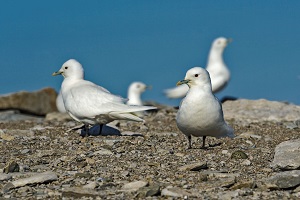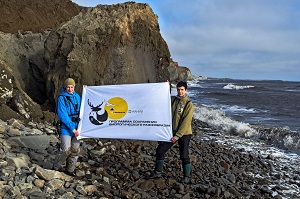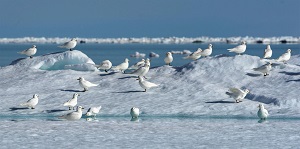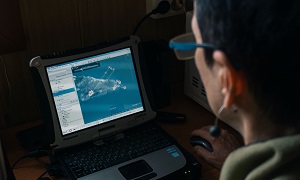Please activate JavaScript in your browser to use all interface options.
Rosneft Making a Significant Contribution to the Study of the Ivory Gull Population
01 April 2022
April 1st is International Bird Day, which was established to draw attention to the need for preserving the species diversity and numbers of birds in their natural habitat. The date is timed to coincide with the start of the birds’ return from their wintering grounds. It has been celebrated officially in our country since 1926.
Environment protection is an integral part of the Company’s corporate culture and operation principles. The Company has been a member of the UN Global Compact for more than 10 years. In 2018, the Company confirmed its commitment to 17 UN Sustainable Development Goals, including goals No. 14 Life Below Water and No. 15 Life On Land.
 Rosneft scientists are observing the birds as part of environmental monitoring. Biologists work on geophysical vessels and escort vessels. They collect data on species composition, bird occurrence and migration routes. Scientists report considerable diversity and abundance of birds in the northern seas, especially on ship transits along the mainland coast and islands. The Company develops biosphere monitoring programmes based on the data it collects during project implementation.
Rosneft scientists are observing the birds as part of environmental monitoring. Biologists work on geophysical vessels and escort vessels. They collect data on species composition, bird occurrence and migration routes. Scientists report considerable diversity and abundance of birds in the northern seas, especially on ship transits along the mainland coast and islands. The Company develops biosphere monitoring programmes based on the data it collects during project implementation.
 Since 2020, Rosneft has been implementing a targeted innovative ‘Assessment of Arctic ecosystem sustainability based on research into the dynamics of key species’ project as part of the Business and Biodiversity national project and a cooperation agreement with the Russian Ministry of Natural Resources. One of the species under study is the Ivory gull population, which is one of the indicators of the sustainable state of Arctic marine ecosystems.
Since 2020, Rosneft has been implementing a targeted innovative ‘Assessment of Arctic ecosystem sustainability based on research into the dynamics of key species’ project as part of the Business and Biodiversity national project and a cooperation agreement with the Russian Ministry of Natural Resources. One of the species under study is the Ivory gull population, which is one of the indicators of the sustainable state of Arctic marine ecosystems.
The Ivory gull studies are carried out by the Arctic Research Centre (part of the Rosneft Oil Company) with the involvement of specialists from the Arctic and Antarctic Research Institute (St. Petersburg). In 2021, scientists analysed material that had been collected during the 2020 expedition in the islands of the Kara Sea. For the first time, the white blood cell formula of Ivory gulls has been described and comprehensive studies have been carried out to assess the stress level of the birds and the health parameters of the population.
 In the 2022 field season, the Ivory gull surveys will continue in the area of the islands of the north-eastern Kara Sea. Collecting data on the presence and numbers of Ivory gull colonies is planned to be carried out during aerial surveys by visual observation as well as by photo and video recording means. Specialists will conduct ringing, tagging and biometric examinations of the individuals, and take samples for analysis.
In the 2022 field season, the Ivory gull surveys will continue in the area of the islands of the north-eastern Kara Sea. Collecting data on the presence and numbers of Ivory gull colonies is planned to be carried out during aerial surveys by visual observation as well as by photo and video recording means. Specialists will conduct ringing, tagging and biometric examinations of the individuals, and take samples for analysis.
Note for Editors:
The Ivory gull, a rare and protected species, is the smallest and most endemic species of Arctic seabird with a limited breeding ground. Most of the global population nests in Russia from Spitsbergen eastward to the Laptev Sea. Included in the Red Book of the Russian Federation and the Red List of the International Union for Conservation of Nature.
The Ivory gull lives permanently in the Arctic. It is also referred to as a feathered polar bear, as it is so closely associated with the high latitudes. Even the population size of the Ivory gull is comparable to that of the main polar predator and they often live side by side.
The remoteness and inaccessibility of ivory gull’s habitat and nesting areas and uneven distribution through the habitat area affect fragmentation of information on the number of the species and its dynamics, territorial links and population structure.
Ivory gulls are characterised by movements during the non-breeding period. The Ivory Gull is a typical seabird and only goes on land during the breeding season. Young and skip-breeding birds stay exclusively at sea and roam widely in the Arctic Ocean waters within the drifting ice zone.
The Ivory gull is very adaptable in its choice of nesting habitats. The vast majority of Ivory gull colonies are located in a variety of mountainous and rocky habitats. There are also nesting sites at artificial sites (e.g. weather stations) in areas that have been developed by people.
Rosneft
Information Division
April 1, 2022

-315xx70.png)

